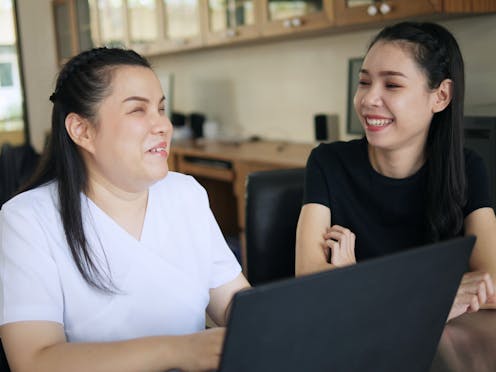Source: The Conversation (Au and NZ) – By Abby Foster, Allied Health Research Advisor, Monash Health; Adjunct senior lecturer, La Trobe University; Adjunct research fellow, School of Primary & Allied Health Care, Monash University

The Royal Commission into Violence, Abuse, Neglect and Exploitation of People with Disability has shared its final report. In this series, we unpack what the commission’s 222 recommendations could mean for a more inclusive Australia.
With the release of the disability royal commission’s final report, the harrowing treatment of people with disabilities in Australia has been starkly displayed.
Just prior to the report’s release, media reports about abuse and neglect prompted National Disability Insurance Scheme (NDIS) commissioner Tracy Mackey to say anyone on the scheme who is concerned about the care they’re receiving and doesn’t have someone to advocate for them should get in touch with the scheme’s quality and safety commission.
But this fails to acknowledge the systemic barriers people with communication disability face. For many, picking up the phone or completing an online form without support is not possible.
Communication is a human right
As part of the United Nations’ Declaration of Human Rights, everyone has the “right to freedom of opinion and expression”.
Acknowledging this, the disability royal commission made specific recommendations around enabling autonomy and access through “communication access”. Acknowledging that failure to do so can lead to poor health, education, employment and justice outcomes, with increased risk of harm during emergencies and natural disasters.
Communication access is necessary for everyone in society, but especially for the 1.2 million Australians who live with a communication disability.
Read more:
Here’s why we need a disability rights act – not just a disability discrimination one
But what does ‘communication access’ mean?
Communication is enormously diverse. We use spoken, written and sign language, gesture, pictorial and digital forms, facial expression, vocalisation, and physical expression to convey meaning. Through these, we can communicate our needs, thoughts and concerns.
Critically, the success of any communicative attempt requires the communication form to be acknowledged, valued and supported. Our environment has a profound impact on how successful communication is – irrespective of a person’s abilities or impairments.
Over the last 40 years we have witnessed a significant shift in attitudes towards people with disability in Australia. There is now legal entitlement for “people with disability to exercise choice and control”.
An independent review of the NDIS is due to report by the end of this month with pressure on costs and growth to ensure sustainability. But enabling people to communicate and exercise choice demands we design and resource accessible communication environments.

ABO PHOTOGRAPHY/Shutterstock
What’s it like to live with a communication disability?
Every day, people experience barriers to receiving and sharing information. These barriers can affect how they engage in meaningful interactions and how safe they feel. Inadequate communication accommodations can lead to difficulties accessing health care, using public transport, even ordering a coffee.
The disability royal commission exposed failures that have caused immense harm. The agency of people living with communication disability has not been respected, with devastating consequences.
Communication barriers exist within the context of high rates of abuse, violence and deprivation of basic needs, including food, shelter, or assistive aids. These rates are almost double those reported for people living without disability.
Read more:
The disability royal commission heard horrific stories of harm – now we must move towards repair
What is communication access?
Communication access occurs when everyone can meaningfully access information and get their message across. The commission called it “a critical safeguard against violence, abuse, neglect and exploitation”.
Yet common approaches to communication accessibility – including those used by government bodies such as the National Disability Insurance Agency (which administers the NDIS) – have limited value.
The commonly applied Easy Read format – which combines text with layout and imagery to explain information – for example, lacks standardised design principles. It is only useful for supporting specific groups.
Universal design principles go someway in supporting agency for people with communication disability. These principles aim to recognise, value and accommodate a broad range of users of specific products or environments. But tailored attention to individual communicative requirements is essential too.
What should happen next?
There have been calls to enhance communication access for many years. While the commission’s recommendations are an important step, the real challenge lies ahead.
The government taskforce charged with acting on the commission’s recommendations should begin by acknowledging the expertise of people with communicative disability.
Co-design is a core tenet of the NDIS; however, people with communication disabilities are frequently excluded from sharing their perspectives. So governments need to look for ways to make co-design communicatively accessible. This must include engaging with multiple modes of communication, including visual aids, key words, augmentative communication, and physical forms of expression. People with communication disability must play a central role in all stages of the policy design process: as informants, design partners and users.
NDIS funding models must cover making a person’s support and service network an accessible communication environment. People with communication disability tell us that time, sustained engagement and relationship building are essential. While strategies are person-specific, practical considerations include ensuring access to assistive equipment and devices, providing choices, checking own understanding, and paying attention to non-verbal communication.
The costs of doing so are offset by the economic value of better health and well-being, employment, education, health, leisure and access to justice.
As the disability royal commission showed, poor oversight has resulted in significant harm, with inadequate safety and incident reporting measures that have translated to increased risk for people experiencing barriers to communicating their concerns.
At a minimum, communication access standards should ensure disability providers have base-level skills to recognise and support diverse forms of communication. Feedback and complaint mechanisms must also go beyond traditional formats of written and verbal communication.
As a community we must learn, not just from the stories and experiences shared with and by the disability royal commission, but also from how people with disability were supported to provide them. Through acknowledgement of the diversity of communication and by providing communication supports, we now have the opportunity to build inclusive environments.
![]()
Abby Foster consults to and is a certified practising member of Speech Pathology Australia. She is a research affiliate with the Centre for Research Excellence in Aphasia Recovery and Rehabilitation. She is affiliated with Yes23 campaign and Healthy Futures
Lucette Lanyon consults on inclusion of people with communication disability within organisational structures and clinical research. She receives funding from the Stroke Foundation and is a research affiliate with the Centre for Research Excellence in Aphasia Recovery and Rehabilitation.
– ref. For people with communication disability, complaining about their treatment isn’t so simple – https://theconversation.com/for-people-with-communication-disability-complaining-about-their-treatment-isnt-so-simple-214717








